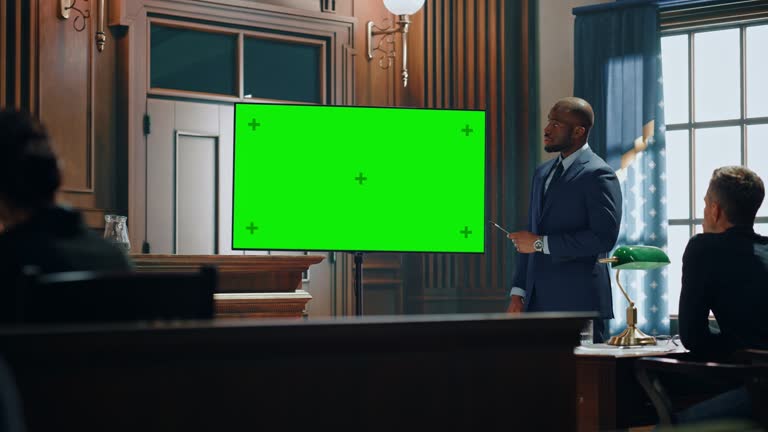Navigating Complicated Situations: Exactly How to Establish Efficient Trial Presentations for Ideal Results
Navigating Complicated Situations: Exactly How to Establish Efficient Trial Presentations for Ideal Results
Blog Article
Navigating the Complexities of Test Presentations: Tips for Seamless Delivery and Compelling Arguments
In the realm of lawful process, the art of trial discussion stands as an important determinant of success. The intricacies inherent in trial presentations call for a delicate balance of skill, finesse, and strategy.

Understanding Test Goals
To effectively navigate a test, it is important to have a clear understanding of the purposes that require to be attained. Prior to entering the courtroom, legal teams should specify their goals and desired results. These goals function as leading concepts throughout the test, forming approaches and influencing decision-making procedures.
Comprehending test objectives includes a comprehensive analysis of the case, lawful precedents, and the customer's benefits. Trial Presentations. It requires a meticulous exam of the realities, recognizing crucial concerns, and preparing for prospective challenges. By establishing certain and measurable objectives, attorneys can customize their presentations and debates to straighten with the preferred results
Moreover, a clear grip of test goals makes it possible for legal groups to focus on proof, witnesses, and legal disagreements effectively. It allows for the growth of a meaningful story that reverberates with the judge and court, strengthening the total situation discussion.

Organizing Proof Successfully
Having a clear understanding of test purposes lays the foundation for arranging evidence effectively in lawful procedures. By lining up the presentation of proof with the desired results of the test, legal groups can strengthen their arguments and boost their persuasiveness.
Another crucial element in organizing proof effectively is developing a sensible flow. Providing proof in a consecutive and coherent manner can assist construct a compelling story that supports the lawful disagreements being made. Additionally, utilizing aesthetic help such as graphes, graphs, or timelines can further improve the organization of evidence and help in making clear intricate partnerships or series of events.
Additionally, ensuring that all evidence offered is appropriate and acceptable to the case is vital. Inadmissible or pointless proof can diminish the strength of the argument and possibly damage the reputation of the here and now celebration. A precise testimonial and choice process should be carried out to include only the most impactful and legitimately audio evidence in the test discussion.
Crafting Influential Narratives
Crafting compelling stories plays an essential role in offering influential disagreements throughout lawful proceedings. When creating a story for a trial discussion, it is necessary to establish a clear story that highlights crucial points and attaches them in a meaningful fashion. By weaving with each other evidence, testament, and legal debates into a persuasive and natural narrative, lawful professionals can successfully advocate for their customers and enhance the chance of a positive outcome in the court.
Mastering Aesthetic Help
Efficient usage of visual help is key to improving the influence and clearness of test presentations. Aesthetic aids, when utilized tactically, have the power to streamline complicated information, enhance bottom lines, and leave a long lasting perception on the court and jury. To grasp aesthetic aids in trial discussions, it is essential to make sure that they are clear, concise, and appropriate to the debates being made.
When incorporating aesthetic help, such as graphes, pictures, charts, or timelines, into a test discussion, it is important to keep them visually appealing yet expert. The visuals need to enhance the verbal arguments, offering a visual representation of the details being reviewed without overwhelming the audience with unnecessary details.
Moreover, exercising with the aesthetic aids beforehand is crucial to guarantee a seamless delivery throughout the trial. Acquainting oneself with the web content, shifts, and timings of each visual aid can help keep the circulation of the discussion and prevent technical problems that might emerge.
Delivering Impactful Closing Debates
An engaging closing disagreement serves as the end result of a trial discussion, encapsulating the core story and convincing the judge and court towards a positive decision. Begin by laying out the primary arguments that support your customer's setting, emphasizing why the proof presented throughout the trial sustains your narrative.
Furthermore, integrating psychological allure can further enhance your closing disagreement. Inevitably, a well-crafted closing argument ought to leave an enduring impact, engaging the court and court to rule in your client's favor.
Conclusion
In final thought, grasping test discussions entails understanding objectives, organizing anchor evidence, crafting narratives, using visual aids, and providing impactful closing disagreements. By carrying out these approaches properly, legal representatives can present their case seamlessly and make compelling arguments in the courtroom. It is crucial to navigate the complexities of test discussions with accuracy and ability to accomplish success in lawful procedures.
By lining up the presentation of evidence with the desired end results of the test, lawful teams can enhance their arguments and enhance their persuasiveness (Trial Presentations). To master aesthetic find more information help in click here for more trial presentations, it is essential to ensure that they are clear, succinct, and pertinent to the disagreements being made
A compelling closing argument offers as the end result of a trial presentation, enveloping the core story and convincing the judge and court in the direction of a beneficial decision. Begin by laying out the major disagreements that support your customer's setting, emphasizing why the proof provided throughout the trial sustains your narrative.In conclusion, understanding trial presentations entails comprehending objectives, arranging evidence, crafting stories, using visual help, and delivering impactful closing debates.
Report this page